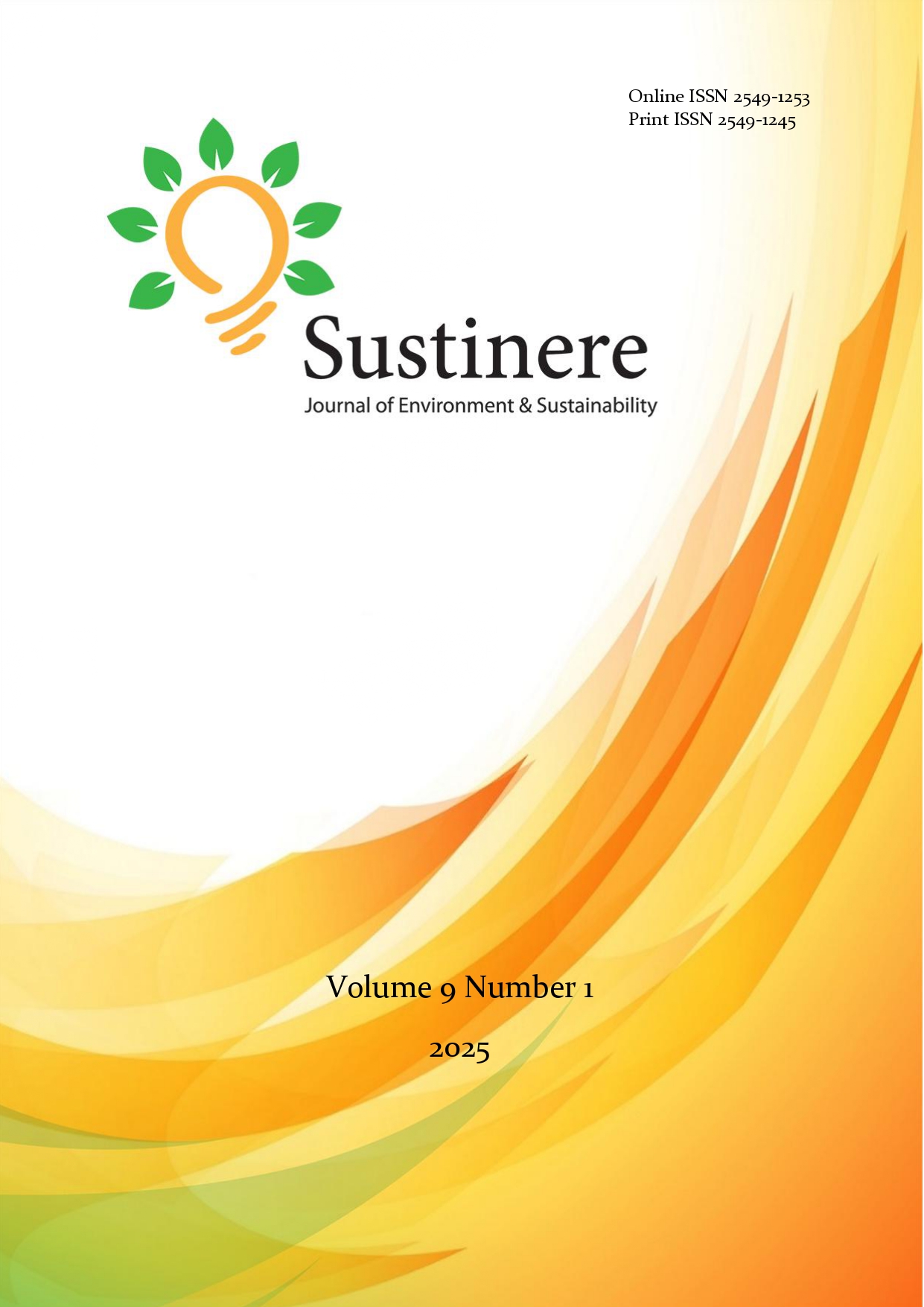Sustainable building: Achieving thermal comfort in hot and humid climate using building performance simulation
Main Article Content
Abstract
The scientific community has established a clear link between the built environment and various environmental problems. Various strategies have been implemented to mitigate the negative impacts of buildings and to address broader environmental challenges. One such strategy is the adoption of sustainable building practices. Among the factors contributing to the environmental impacts of buildings, efforts to achieve thermal comfort play significant role. Particularly due to the energy consumption involved. At the same time, thermal comfort is also a critical factor influencing human productivity, including academic performance. Comfortable learning environments are known to enhance students’ learning outcomes. This research presents a case analysis conducted at State Elementary School 91 Sipatana, Gorontalo City, Indonesia. Measurements were carried out on December 24, 2022, from 06.00 to 18.00. Room temperature was recorded using an Elitech GSP-6 data logger, and further simulations were carried out using Ladybugs and Honeybees. The purpose of this study is to evaluate building performance in achieving thermal comfort by considering solar radiation exposure, roof surface temperature, room temperature, and Predicted Mean Vote (PMV) values. Comparisons were made across different building materials, including variation in roofing, wall types, and ventilation systems. The wall in the existing structure are composed of concrete with a fiber wall. The findings highlight the impact of roofing materials, wall construction, and ventilation on the PMV, roof surface temperature, and indoor air temperature. Based on-site measurements, the average classroom temperature was 30.5°C. Among the simulation configurations, Model 3 which featured a metal roof with a cool roof technology, concrete walls, and added ventilation demonstrated the best thermal performance. It maintained a roof surface temperature just above 25°C and an indoor air temperature close to 30°C, showing the effectiveness of cool roof technology and adequate ventilation in reducing heat accumulation.
Article Details

This work is licensed under a Creative Commons Attribution-NonCommercial-ShareAlike 4.0 International License.
ASHRAE. (2020). Thermal Environmental Conditions for Human Occupancy. 8400.
Belis, C. A., Karagulian, F., Amato, F., Almeida, M., Artaxo, P., Beddows, D. C. S., Bernardoni, V., Bove, M. C., Carbone, S., Cesari, D., Contini, D., Cuccia, E., Diapouli, E., Eleftheriadis, K., Favez, O., El Haddad, I., Harrison, R. M., Hellebust, S., Hovorka, J., … Hopke, P. K. (2015). A new methodology to assess the performance and uncertainty of source apportionment models II: The results of two European intercomparison exercises. Atmospheric Environment, 123, 240–250. https://doi.org/10.1016/j.atmosenv.2015.10.068
Eltaweel, A., & SU, Y. (2017). Parametric design and daylighting: A literature review. Renewable and Sustainable Energy Reviews, 73, 1086–1103. https://doi.org/10.1016/j.rser.2017.02.011
Gagge, A. P., & Stolwijk, J. A. J. (1967). Comfort and Thermal Sensation and Associated Physiological Responses at Various Ambient Temperature. 20, 1–20.
García-Alonso, J., Rodriguez-Sanchez, N., Misra, S. K., Valsami-Jones, E., Croteau, M. N., Luoma, S. N., & Rainbow, P. S. (2014). Toxicity and accumulation of silver nanoparticles during development of the marine polychaete Platynereis dumerilii. Science of the Total Environment, 476–477, 688–695. https://doi.org/10.1016/j.scitotenv.2014.01.039
Johra, H. (2021). Thermal Properties of Building Materials - Review and Database. Department of the Built Environment, Aalborg University, DCE Techni, 1–23.
Lagios, K., Niemasz, J., & Reinhart, C. F. (321 C.E.). Animated Building Performance Simulation (Abps) – Linking Rhinoceros/Grasshopper With Radiance/Daysim. SimBuild 2010, 321–327.
Lala, B., & Hagishima, A. (2022). A Review of Thermal Comfort in Primary Schools and Future Challenges in Machine Learning Based Prediction for Children. Buildings, 12(11). https://doi.org/10.3390/buildings12112007
Latifah, N. L., Perdana, H., Prasetya, A., & Siahaan, O. P. M. (2013). Kajian Kenyamanan Termal pada Bangunan Student Center ITENAS Bandung. Reka Karsa, 1–12.
Lima, L., Trindade, E., Alencar, L., Alencar, M., & Silva, L. (2021). Sustainability in the construction industry : A systematic review of the literature. Journal of Cleaner Production, 289, 125730. https://doi.org/10.1016/j.jclepro.2020.125730
Nurhayati, E., Juang, Y., Rajkumar, M., Huang, C., & Hu, C. C. (2015). Effects of dynamic polarization on boron-doped NCD properties and on its performance for electrochemical-analysis of Pb (II), Cu (II) and Hg (II) in aqueous solution via direct LSV. Separation and Purification Technology, 156(Ii), 1047–1056. https://doi.org/10.1016/j.seppur.2015.07.022
Nurulita, Y., Adetutu, E. M., Kadali, K. K., Zul, D., Mansur, A. a., & Ball, A. S. (2014). The assessment of the impact of oil palm and rubber plantations on the biotic and abiotic properties of tropical peat swamp soil in Indonesia. International Journal of Agricultural Sustainability, 13(2), 150–166. https://doi.org/10.1080/14735903.2014.986321
Oliver, A. L. S., Croteau, M. N., Stoiber, T. L., Tejamaya, M., Römer, I., Lead, J. R., & Luoma, S. N. (2014). Does water chemistry affect the dietary uptake and toxicity of silver nanoparticles by the freshwater snail Lymnaea stagnalis? Environmental Pollution, 189, 87–91. https://doi.org/10.1016/j.envpol.2014.02.010
Pratiwi, N., & Attaufiq, M. M. (2024). Comparative Analysis of Performance Between Window and Eco-Cooler to Achieve Thermal Comfort in Hot Humid Climate. IOP Conference Series: Earth and Environmental Science. https://doi.org/10.1088/1755-1315/1361/1/012006
Qingsong, M., & Fukuda, H. (2016). Parametric Office Building for Daylight and Energy Analysis in the Early Design Stages. Procedia - Social and Behavioral Sciences, 216, 818–828. https://doi.org/10.1016/j.sbspro.2015.12.079
Sativa, S.-, & Adilline, P. S. (2021). Evaluasi Kenyamanan Termal Ruang Kuliah IKIP PGRI Wates Kulon Progo DIY. INERSIA Lnformasi Dan Ekspose Hasil Riset Teknik Sipil Dan Arsitektur, 17(2), 165–174. https://doi.org/10.21831/inersia.v17i2.46751
Yenneti, K., & Day, R. (2015). Procedural (in)justice in the implementation of solar energy: The case of Charanaka solar park, Gujarat, India. Energy Policy, 86, 664–673. https://doi.org/10.1016/j.enpol.2015.08.019
Yusuf, A. A., & Francisco, H. (2009). Climate Change Vulnerability Mapping for Southeast Asia Vulnerability Mapping for Southeast Asia. In Economy and Environment Program for Southeast Asia (Vol. 181, Issue December). https://doi.org/10.1158/1541-7786.MCR-07-0267
Zulfiana, I. S. (2019). Kenyamanan Lingkungan Termal Ruang Kuliah (C4) Fakultas Teknik Universitas Ichsan Gorontalo. JTT (Jurnal Teknologi Terpadu), 7(1), 66–69. https://doi.org/10.32487/jtt.v7i1.637

